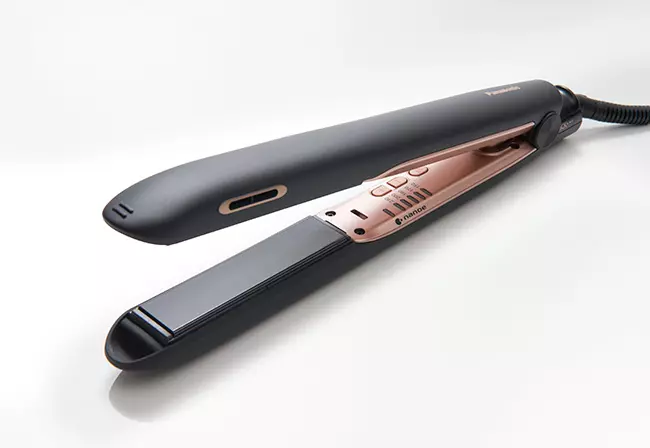
Something weird was going on with Laura Miranda’s left breast; the shape was changing. Two days prior to her noticing that something looked off, she’d had her first mammogram (breast cancer runs in her family, so she’s vigilant about getting the necessary tests). Now, her left breast seemed to be “deflated,” as she describes. It was June of 2016.
She’d gotten implants on a whim at 22 to fulfill the big-busted aesthetic ideal at the time. They were offered to her as a gift by the gym she worked for early in her career as a trainer—the athletic club had a partnership with a plastic surgery group, and she was meant to be a sort of walking advertisement for them.
She suspected the pressure from the x-ray machine had caused a leak in one of the implants since she’d previously read that mammogram techs have to use less force when implants are involved. “I thought, ‘that sucks,’ but figured they were 16 years old, and that’s just part of the game,” says Miranda, who is also now a doctor of physical therapy in New York City.
She could deal with a little asymmetry on her chest. What was unbearable were the symptoms to come.
Miranda started experiencing days-long bouts of fatigue and body aches a few weeks later. “I was launching a business and working crazy hours, so I attributed my symptoms to that,” she says. “I didn’t think to see a doctor.”
But she kept feeling worse. Eventually, she was bedridden every few days. “In 2017, I was dealing with intense brain fog and cognitive decline, writing and concentrating for my work was nearly impossible, I had to nap between every client I trained, and my vision was shaky,” says Miranda. “I was so tired that I couldn’t work out, so I gained weight and my mental health was in a really bad place.”
She visited her GP, then a cardiologist, endocrinologist, and holistic health practitioner. She had high blood pressure, but other than that, all her tests came back normal. Around the same time, her sister sent her a social media post from a model who talked about how her implants had made her sick. “I knew deep down that this was probably what was going on with me,” Miranda says.
Googling led her to a Facebook group called Breast Implant Illness and Healing by Nicole, a page started in 2016 by Nicole Daruda, who had her implants surgically removed in 2013 after suffering for years from symptoms much like Miranda’s, which she believed were linked to the devices in her chest. The procedure is known as explantation, or explant surgery, and involves the removal of both the implants as well as the scar tissue capsules surrounding them.
“I had never heard of breast implant illness, and no doctor ever mentioned it to me,” Miranda says. “But seeing all these women with such similar symptoms, who also had implants, made me realize something was going on here.”
She immediately wanted to get hers removed. “It just made sense.”
Miranda is one of a fast-growing group of women who are opting to have their implants taken out because they believe they’re making them sick.
Roughly 400,000 women a year get implants; just over 100,000 are for reconstruction after surgery like a mastectomy for breast cancer, the other 300,000 are for cosmetic/enhancement purposes. And it’s worth noting that “over 90 percent of those women are pleased with the results and don’t experience health issues,” says Alan Matarasso, MD, plastic surgeon, clinical professor of surgery at Hofstra University/Northwell School of Medicine, and immediate past president of the American Society of Plastic Surgeons (ASPS).
Still, augmentation surgeries, which have been the number one cosmetic surgical procedure in the U.S. since 2006, dropped 14.9 percent from 2018 to 2019, according to annual statistics from The Aesthetic Society. Explantation surgeries, on the other hand, increased 34.4 percent in the same year.
These stats are likely the result of growing concern about the effects implants can have on women’s health—but the condition is still not officially recognized by the medical community or the U.S. Food and Drug Administration (FDA). In fact, most information about breast implant illness (or BII) is being spread via social media groups: Daruda’s Facebook page alone has over 120,500 members, and @breast_implant_illness on Instagram has 66.6K followers.
The thing is, BII isn’t really new—it’s just finally getting public attention. “Women have been complaining of issues with their implants since the 90s—but social media has allowed them to connect to amplify their voices and concerns,” says Diana Zuckerman, PhD, president of the National Center for Health Research, Cancer Prevention and Treatment Fund.
Jade Root, a U.S. Army major and fitness competitor, also found out she was suffering with BII thanks to the BII social media community. She’d gotten implants on the recommendation of her fitness coach seven years ago to make her body appear more proportional and up her chances of success on the stage. She slowly started to develop the classic symptoms often attributed to BII. “I chalked it up to motherhood and my deployment. I was managing a lot,” Root says.
But during a break from bikini competitions, her symptoms became crippling. “I couldn’t recall basic terms I needed to use at work every day, I couldn’t complete the drive to the office without nearly falling asleep, even after getting seven hours of sleep the night before.” Doctors prescribed her two meds for joint pain and numbness and one for sleep, and they attributed her memory loss to anxiety, for which she was prescribed Xanax. “It felt like I was forcing myself to get through every day. I couldn’t live like that.”
Root shared her story on Instagram, to which a friend (who had her own experience with BII) reached out and suggested she look into the BII phenomenon further. “She sent me the symptoms and I checked off damn near every single one. I started crying because it finally made sense,” she says. “It didn’t take much convincing after that. I had my explant surgery scheduled three weeks later.”
The reason so many women are using these online communities to self-diagnose is because many doctors say that breast implant illness (BII) research is too preliminary to say for sure whether it exists.
To be clear, BII is the term used by patients and some docs to describe the pattern of symptoms they suspect are caused by their implants. Common symptoms vary, but these are the ones that have popped up enough to be studied (buckle up, it’s a long list): numbness and tingling in the extremities, joint and/or muscle pain, hair loss, memory loss/cognitive problems, dry eyes and/or blurred vision, chronic fatigue, breast pain, rashes and/or hives, food sensitivity/intolerance, flu-like symptoms and/or low-grade fever, and difficulty breathing.
Unfortunately, BII “isn’t a disease we can test for,” says Dr. Matarasso. Determining whether someone is dealing with BII is more a process of elimination of other possible causes. “It’s a constellation of symptoms that can potentially be linked to many conditions,” he explains. “And we know that breast implants are one of the most common and thoroughly studied medical devices on the market, and again, the mass majority of people who have them are happy with them and don’t develop any health problems.”
Experts honestly don’t know why some women develop these mysterious health issues and others don’t, “but these symptoms can also occur in patients with autoimmune diseases,” says Dr. Matarasso. Basically, it seems as if the immune systems of women with BII are causing their bodies to reject their implants. Whether they’re leaking or not, it appears the silicone in the devices is causing an adverse reaction, which has led some researchers to speculate that implants may be particularly problematic for women who already have autoimmune conditions or a family history. Symptoms tend to get worse with time, though there’s no telling when they’ll appear; some women report them coming on right away, while others don’t experience anything for years after surgery.
Still, new research is pointing to the fact that hundreds of thousands of women aren’t exactly making this up. A study published just last month in The Annals Of Plastic Surgery followed 750 women who had explant surgery in 2017 and 2018, tracking the most commonly reported symptoms of BII (the 11 listed above) before explantation, then from 1 to 1,000 days post-op. The study showed significant improvement in all 11 symptoms immediately following explant surgery, and the improvements were maintained long term. Those results echo the findings of several smaller studies that showed patients who suffered from this type of sickness got better after having their implants taken out.
There’s also breast implant-associated anaplastic large cell lymphoma (BIA-ALCL), a type of lymphoma that develops in the scar tissue capsule and fluid that surrounds the breast implant in the chest. But experts don’t think this cancer is related to BII—and the existence of ALCL isn’t disputed in the medical community, though it is rare. In fact, the FDA issued a recall of specific types of textured breast implants in July 2019 as they’ve been linked to increased risk for this type of cancer, but many women are still unaware of this disease.
Despite all the findings around implants and the potential health risks, those who think they are dealing with BII often cycle through several doctors before their symptoms are taken seriously.
The heavy psychological toll is real, Miranda says. “No one would believe me. Specialists were telling me it was all in my head, or that these were symptoms of depression,” she recalls. “I eventually just stopped going to see doctors because they wouldn’t listen. I reached a point where I was having suicidal thoughts…it was demoralizing to be told over and over that I was fine.”
Thankfully, Miranda found the BII Facebook page, and after doing her own research, found a surgeon who would take out her implants in November 2018. “It sounds insane, but the mental fog, vision issues and pain were gone almost immediately. It felt like coming out of a debilitating flu,” she says.
Miranda had to advocate relentlessly for her own health in order to get the help she needed, a recurring theme in the BII narrative.
Chelsea Harrison, a yoga instructor and former bikini competitor, had to do the same. She got breast augmentation when she was 23. “In one of my first bikini competitions I placed third, and the women in first and second both had implants. I was super self-conscious about it,” she says. A few years later, she started to notice rashes, fatigue, and anxiety, but didn’t link the issues to her implants.
Eventually, she had problems with what’s called capsular contracture, where the scar tissue around the implant hardens and can cause pain. “The first surgeon I visited told me I ‘didn’t want to take my implants out from an aesthetic standpoint,’” Harrison remembers. (It can be surprisingly difficult to find a surgeon willing to do explantation, says Zuckerman, because docs are afraid patients will be displeased with the results. And of course, there are risks with any surgery.)
So, Harrison had to do a deep dive to find the right doctor, and in the process, learned about BII. She was even more motivated to get her implants removed, and found a surgeon who no longer puts in implants, and specializes in explant surgeries. “I felt as if inflammation in my body went down, the corners of my eyes aren’t yellow, I feel like I can take a full breath again, I have energy. And I like how I look now even more than I did with implants,” Harrison says. “But I had to go through a journey of self-acceptance to get to where I am.”
Root is happy with the visual results of her explantation too. “If anything, I’m more confident now because I feel so much better. I was living in a haze before,” she says. “If I had known the risks before getting implants, I 100-percent would have said no.”
A committee of doctors, researchers, and patient advocates are trying to make sure that women *do* know the risks going forward.
In the summer of 2019, the Breast Implant Working Group (which includes Dr. Matarasso and Zuckerman) submitted a proposed black box warning for implant manufacturer websites (like what you might find on a box of cigarettes) and a patient checklist to the FDA for consideration. The checklist is meant to be given to patients who are considering implants for their sign-off, and includes detailed information on the potential health risks associated with them.
“We hear that patients just aren’t getting this information from their doctors, or if they do, it’s a huge 40-to-100-page booklet that’s difficult to read and understand,” says Zuckerman. The FDA then released their own proposed warning and checklist in October 2019 (You can find it starting on page 12 of this document.)
But Zuckerman says that the FDA versions of these warnings use “much weaker” language. “The [Breast Implant Working Group] doesn’t feel like it’s enough, so we sent our criticism along with a petition with over 80,000 signatures to support our black box warning and checklist language.” (She adds that the FDA was working on a response when COVID-19 happened, and then a lot of staff who worked on medical devices for them had to pivot to focus on the safety of COVID tests and products.) Zuckerman and her team are planning to submit a letter to the FDA soon, demanding they address the need for proper warnings for implants ASAP.
The hesitation to adopt strong language around BII may be because several studies have not confirmed the link between breast implants and BII. But, Zuckerman argues, “A lot of these studies that were done in response to early claims from women that their implants were making them sick were funded by manufacturing companies or plastic surgeons, and most did not include enough women who had implants for many years,” she says. “Plastic surgery is big bucks, and it could be less profitable if women are concerned they’ll be harmed; that’s why even doctors who believe in BII have been afraid to speak up about it because they could be ostracized by their colleagues.”
But the tides are changing…somewhat. The ASPS, which is the largest plastic surgeon society in the world, has endorsed the Breast Implant Working Group’s patient checklist and likely will endorse the black box warning with a few proposed tweaks, says Zuckerman. She hopes the FDA will adopt the warning and checklist soon.
Until these developments come to fruition, women struggling with implant issues continue to find solace and support in the massive BII community.
Sadly, explant surgery isn’t typically covered by insurance, so many women are living with the condition until they can save up enough money to pay the $5,000 to $8,000 it costs (not including a breast lift, which most patients opt for since implants have stretched their skin). For many women, having to come to terms with a new body also makes them hesitant.
In Root’s case, the decision to have her implants taken out was a simple one. “Ultimately, my health came first,” she says. But she was still nervous about how she’d look, and how she’d perform in bikini competitions, without larger boobs. “This is a huge issue in the bodybuilding arena,” she says. “Women are living with BII and are terrified to get explant surgery because they’re afraid it will change how they’re viewed on stage.”
But now, post-explant, Root’s symptoms are slowly improving, and she no longer needs any of the medication she was taking before. As someone deeply immersed in the wellness world, she couldn’t believe she hadn’t even heard whispers of BII when she got her implants, and she hopes being transparent about her experience can spread knowledge. “I have a 9-year-old daughter, and I’m teaching her self-value and self-worth through my experience. Hopefully, she never feels like she needs to get implants,” she says.
“It’s such a paradox in the fitness world,” says Miranda. “You’re supposed to be the picture of health, but your body is being destroyed from the inside.” Miranda retreated—both on social media and IRL—when she was sickest. But after explantation, when she started to feel okay again, she decided to open up about what had happened to her on her social platform. As is the case for many people in the fitness community with an audience, sharing her experience has helped others feel less alone in their symptoms.
Ultimately, whether BII gets formal medical recognition or not, the bottom line is that women are experiencing something—and they deserve to be taken seriously. “There’s a group of women who have to be heard and studied,” says Dr. Matarasso. There’s still a lot that the medical community doesn’t know when it comes to BII, what it constitutes, and who could be at risk, he says, but “these symptoms shouldn’t be minimized. They’re debilitating. And for people who have symptoms, breast implants should be one of the first things to consider could be causing them.”
For Miranda, explantation was the only option. A month and a half post-op, her fatigue was gone and she was back to teaching fitness classes like she had before. Now, she feels like her naturally energetic self again. “Being so sick, not being able to be the active, motivated, outspoken person that I am, had made me lose all will to live. If I had listened to the specialists I was seeing and done nothing about my implants, I know I wouldn’t be here today.”
You Might Also Like








